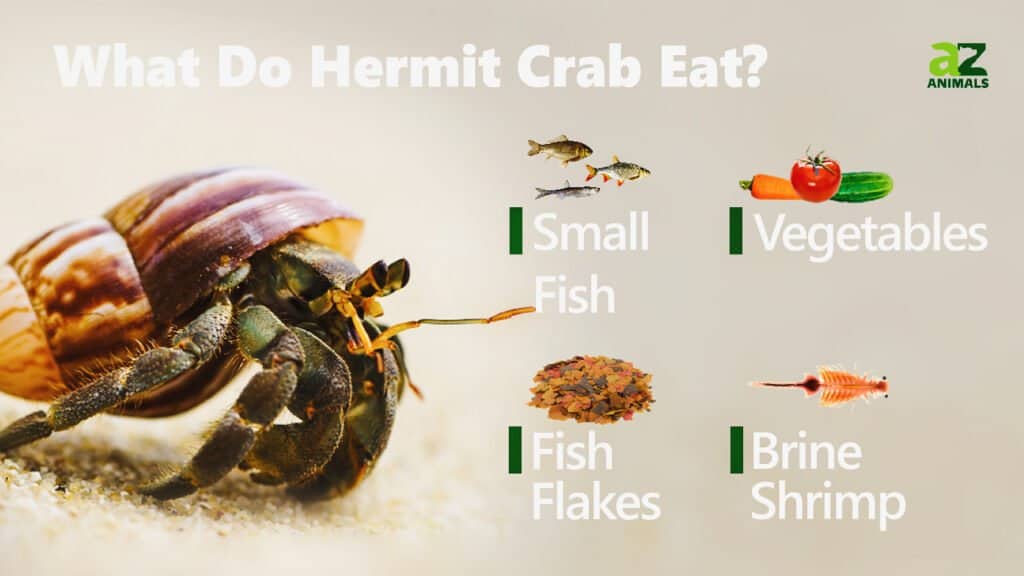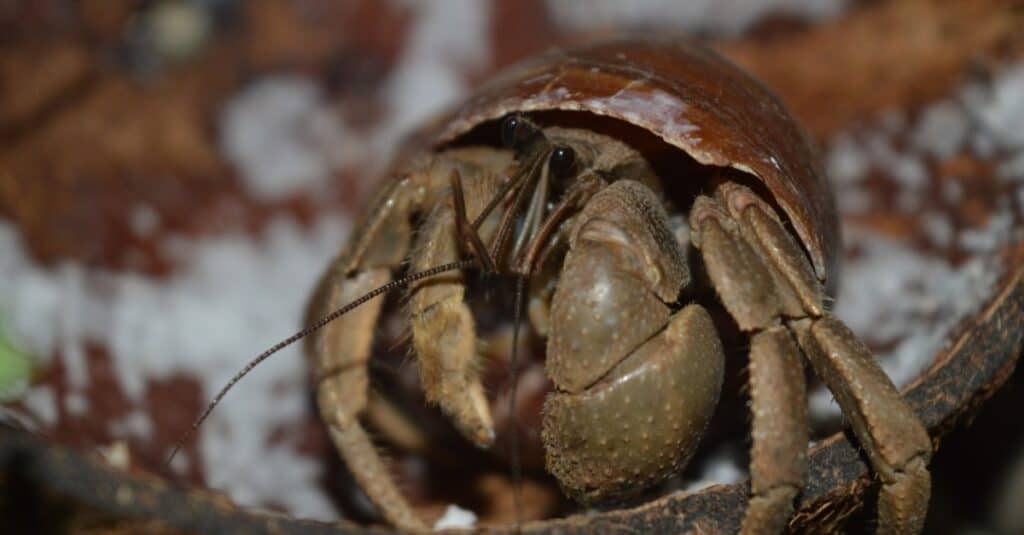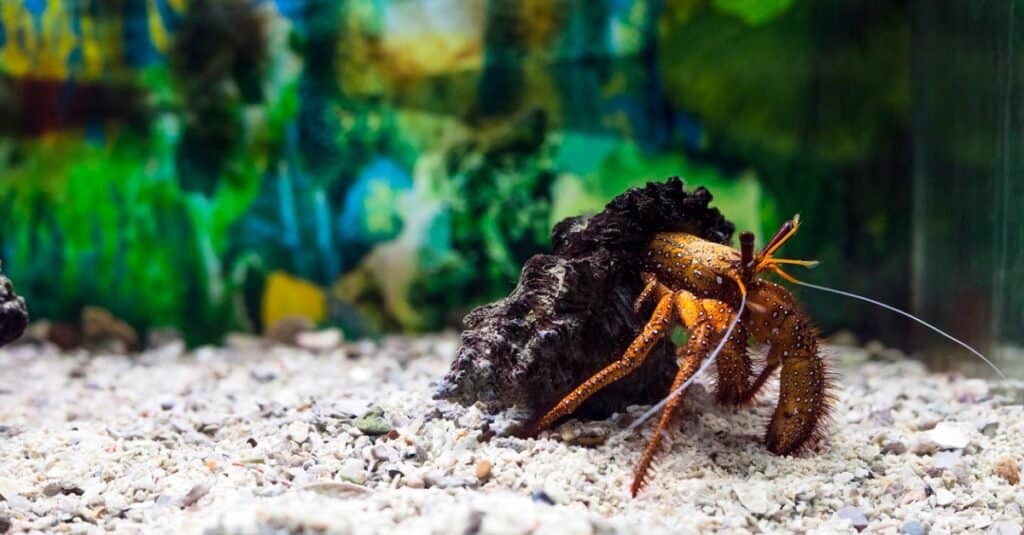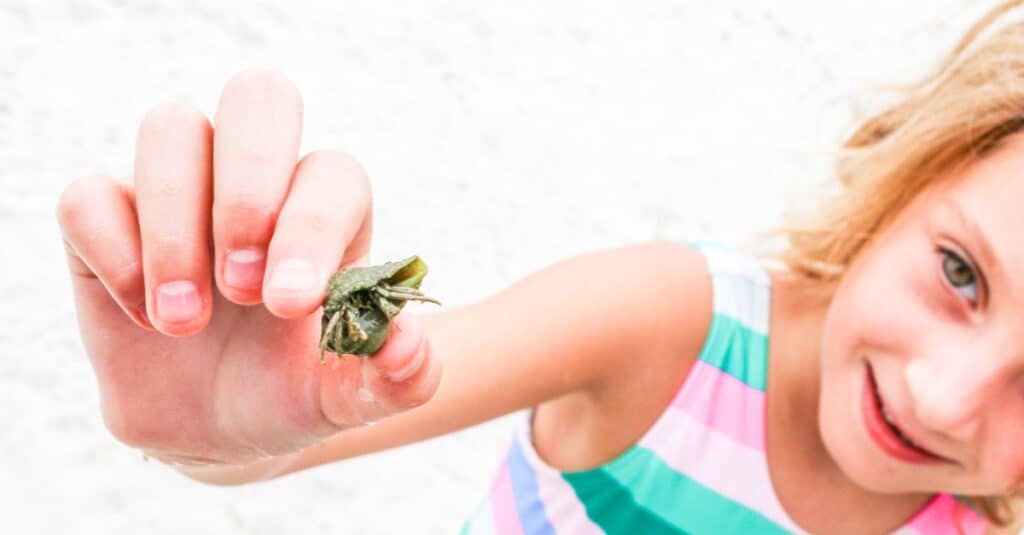Have you ever seen a hermit crab or owned one as a pet? These tiny decapod crustaceans are known for their interesting habit of finding shelter. Rather than growing their own protective shell, such as some other animals do, hermit crabs must inhabit shelters produced by others. You can often find them hiding in snail shells, but they’ll use just about anything for a home. This curious behavior is what makes them popular pets, as people enjoy watching them grow into different homes. In total, there exist more than 800 species of hermit crab, each of which must carry a mobile home on its back. While some hermit crabs live mostly in the water, others spend a majority of their time on land. Some species measure only a few millimeters long, while others measure over three feet long. Given these differences, it begs the question, “what do hermit crabs eat?”
In order to answer this question, we’ll take a moment to study the dietary habits of hermit crabs. We’ll first discuss what hermit crabs like to eat. Then, we’ll delve into a discussion of how hermit crabs hunt and forage for food. Next, we’ll compare what hermit crabs eat in the wild versus hermit crab food given to pets. Finally, we’ll end with a conversation about what baby hermit crabs eat. So, let’s get started answering the question, “what do hermit crabs eat?”
What Do Hermit Crabs Like to Eat?

Hermit crabs are omnivores, which means they eat both plant and vegetable matter. Opportunistic eaters, they are not known for being picky and will eat pretty much anything they can find. That said, they rarely if ever eat live prey aside from tiny microorganisms. As such, plant material and dead or decaying animal matter make up the bulk of a hermit crab’s diet. Given their varied tastes, it would take too long to list off all the foods that hermit crabs like to eat. To make things easier, we’ve identified 10 foods that most hermit crabs commonly eat. These foods are the ones that hermit crabs frequently consume, and the ones we’ll explore in more detail. The 10 foods that hermit crabs like to eat include:
- Plankton
- Insects
- Fish
- Worms
- Fruits
- Vegetables
- Nuts
- Eggs
- Seaweed
- Shrimp
How Do Hermit Crabs Hunt and Forage for Food?

Hermit crabs possess a highly refined sense of smell that helps them to locate food.
©iStock.com/jamechi
Hermit crabs possess many of the same senses as humans, with some being more refined than others. They use sight, touch, taste, sound, and smell to locate food and survive in the wild. One of a hermit crab’s most valuable senses is its sense of smell. They possess hundred of little antennae covered with short hairs that they use to detect scents. For example, robber crabs can locate coconuts from far away, and some hermit crabs can smell death. Hermit crabs also possess a heightened sense of taste. This likely explains why some hermit crabs prefer certain foods over others. In addition, hermit crabs also use their eyesight to locate food. They possess 360-degree vision, and can differentiate between colors, but struggle with shapes. Also, while hermit crabs can hear medium and low frequencies, they don’t rely on their hearing much to find food.
Hermit crabs are omnivorous scavengers, meaning they spend the majority of their time roaming around in search of food. Once a hermit crab detects a scent it likes it will move in the direction of the potential meal. A large part of their brain is devoted to processing smells and hermit crabs will relentlessly follow their noses in search of food. Additionally, if a hermit crab sees another hermit crab eating, it will make its way in that same direction to share in the spoils. Hermit crabs will use their claws to grab and break up food into smaller pieces for them to eat. Although they mostly eat plant matter and dead and decaying animal flesh, they will also eat live animals. However, given their slow speed, they struggle to catch fast prey. Usually, the only live animals they eat are slow-moving prey such as worms.
What Do Hermit Crabs Eat in the Wild?
In the wild, hermit crabs will eat pretty much anything that they can find. As opportunistic omnivorous scavengers, they will eat whatever they can get their claws on. That said, there are some foods that many hermit crabs eat. Smaller species will eat microscopic organisms such as plankton. Algae, wood, moss, and other vegetable matter also make up a large part of a wild hermit crab’s diet. Many species are drawn to decaying animal flesh. As such, they often eat dead fish, as well as dead insects, mussels, and other shellfish. However, some hermit crabs have evolved specific tastes and adaptations to certain environments. For example, the giant robber crab is the largest hermit crab and terrestrial land crab. These giants eat primarily fleshy fruits, nuts, and seeds, including coconut. Basically, if a hermit crab can catch it or find it, it will probably eat it.
What Do Pet Hermit Crabs Eat?

Many hermit crab owners opt to feed their pet a high-quality hermit crab supplement.
©iStock.com/dmf87
Many people decide to keep hermit crabs as pets because they are relatively easy to care for and exhibit interesting behaviors. That said, if you decide to keep a pet hermit crab, you’ll have to know how to properly care for it. This includes feeding it appropriate food. Many hermit crab owners opt to feed their pet high-quality hermit crab food. Whether flakes or pellets, these specially formulated foods provide a hermit crab with the essential nutrition it needs. You can also include fresh vegetables like carrots and lettuce, or fruits like coconut or mango. Additionally, you can feed your hermit crab things like brine shrimp, crickets, or mealworms. However, you’ll want to make sure these foods are pre-killed before giving them to your pet. Furthermore, make sure to give your hermit crab access to fresh water and replace its food regularly.
What Do Baby Hermit Crabs Eat?

Baby hermit crabs are called zoea and go through several stages before evolving into adults.
©iStock.com/Lisa5201
Baby hermit crabs, or zoea, go through a number of life-stage cycles before they mature into adults. In the first stage, they look like larvae, before eventually forming legs and other appendages. On average, the transformation from a baby to a juvenile hermit crab takes around 2-3 months. During that time, hermit crab babies eat many of the same foods as adult hermit crabs. If you own a baby pet hermit crab, you can feed it the same foods as an adult crab. Start out with a hermit crab supplement. Then, add things like fruits and vegetables including mango, banana, sweet potato, carrot, or corn. You can try introducing pre-killed crickets or small mealworms. Just make sure to keep an eye on your hermit crab’s tank and replace its food regularly. Pay attention to what foods it is eating and which ones it avoids, and make changes accordingly.
Hermit Crabs’ Predators
Now we’ve taken a peek at hermit crab food, it’s time to look at what creatures consider hermit crabs to be food themselves.
Several forms of marine life consider hermit crabs to be both tasty and nourishing. Clingfish, gunnels, pricklebacks, snailfish, and starfish are included in that category.
Hermit crabs also have to worry about other crabs too, as well as predators of the avian variety such as crows and gulls.
Are hermit crabs edible from a human point of view? Absolutely. The bigger, the better, since larger decapods contain more meat. That said, you’re unlikely to find this variety of decapod on the menu in your neighborhood seafood restaurant since culinary establishments prefer offering their clientele other meatier species of crustacean.
The photo featured at the top of this post is © iStock.com/MATTHIASRABBIONE
Thank you for reading! Have some feedback for us? Contact the AZ Animals editorial team.







